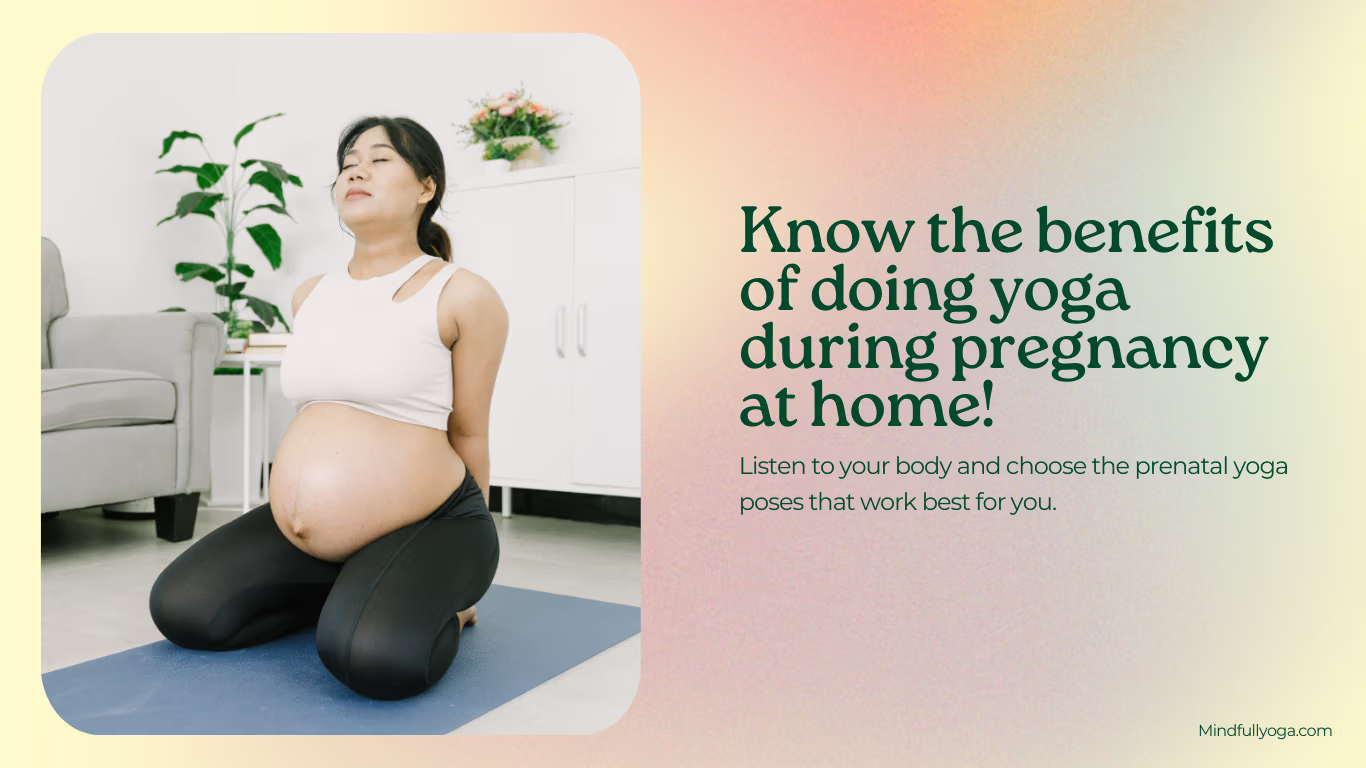
Pregnancy is a special phase of women’s life, in which many changes occur in their body. Prenatal yoga is an excellent method to maintain physical and mental health during this time. Not only is it a gentle way to stay active, but it is also helpful in reducing pregnancy-related discomforts and preparing the body for delivery.
This comprehensive guide will provide you with detailed information about the benefits of prenatal yoga, safety precautions, recommended postures, breathing techniques, and necessary modifications for every trimester, so you can practice safe and effective prenatal yoga at home.
Understanding the Benefits of Prenatal Yoga
Thinking about starting yoga when pregnant? Prenatal yoga offers many benefits. It helps with physical discomforts and enhances mental health. It is great for your body and mind during pregnancy. Whether you’re new to prenatal yoga or want to practice at home, this is a great addition to your routine.

Some of the major benefits of prenatal yoga include:
- Reduction in back pain: This yoga asana strengthens the muscles that support the spine, which helps maintain proper posture and reduce stress on the lower back. Light stretching relieves tension from the back muscles, reducing pain and stiffness.
- Improves flexibility and balance: Light stretches and postures increase flexibility, which reduces the risk of injury and improves balance as the center of gravity shifts.
- Reduction in swelling: This yoga poses promotes blood circulation, which helps reduce swelling in the feet and ankles.
- Good sleep: The calming effects of yoga can improve the quality and duration of sleep.
Mental And Emotional Benefits
- Reduction in stress and anxiety: The mindfulness and meditation practices included in prenatal yoga calm the mind, reduce stress hormones, and promote relaxation.
- Improves mood: Regular exercise improves mood and overall health.
Preparing for Labor and Delivery
- Increase in strength and stamina: This yoga strengthens the muscles required during delivery.
- Better breathing techniques: This yoga teaches breathing techniques which prove to be extremely useful during delivery.
- Increase in physical awareness: This yoga promotes a deeper connection with your body, which can be helpful during labor.
When to Start and Stop Your Prenatal Yoga Practice
Wondering how do I start prenatal yoga? You can start as soon as you find out you’re pregnant. Many women start in the first trimester and keep going until they give birth. If you’re thinking can you do prenatal yoga at home?, yes, you can. With a few simple changes, you can practice safely at home.
To start, begin with gentle poses and breathing. As your pregnancy grows, you’ll learn to adjust your practice. Always stop if you feel any pain. Talk to your doctor or a prenatal yoga teacher for help making your practice safe and right for you.
Here are some tips for starting your prenatal yoga:
- Start slow and gentle, even in the first trimester
- Pay attention to your body and take breaks as necessary
- Avoid poses that cause discomfort or pain
- Stay hydrated and practice on an empty stomach
By following these tips and listening to your body, you can enjoy prenatal yoga’s benefits. Always put your safety and comfort first. Don’t hesitate to ask for help or advice when you need it.
Essential Safety Guidelines for Prenatal Yoga at Home for Beginners
Starting your prenatal yoga journey is exciting. But, it’s key to know the safety rules for a healthy practice. Always talk to your healthcare provider, even if you’re new to yoga or have health issues. They can guide you on when to start and how to practice safely.
- Medical clearance: Get medical clearance from your doctor or midwife, especially if you have any pre-existing health problems or pregnancy-related complications.
- Pay attention to your body: Observe your body’s signals carefully. Stop immediately if you feel any pain, discomfort, dizziness, vomiting, vaginal bleeding, or contractions.
- Hydration: Keep yourself hydrated by drinking plenty of water before, during, and after exercise.
- Empty stomach or light breakfast: Practice on an empty stomach or after having a very light breakfast to avoid nausea.
- Qualified Instructor: If possible, be sure to take some prenatal yoga classes from a certified instructor to learn proper alignment and modifications. Even if you plan to practice at home, this initial guidance is extremely important.
- Safe Environment: Create a safe practice space at home.
Getting medical clearance is a must, if you have health problems. This ensures your practice is safe. Watch out for signs like dizziness, nausea, or vaginal bleeding. If you see these, stop and talk to your doctor right away.
Postures to Avoid During Pregnancy
Some postures generally not recommended during pregnancy, especially in the second and third trimester:
- Deep twists: These can cause pressure on the abdomen.
- Inversions, such as headstands and handstands
- Poses that put pressure on the abdomen, such as boat pose and plow pose
- Backbends: Deep backbends can cause lower back strain.
- Over-stretching postures: Hormonal changes increase your flexibility, so avoid over-stretching.
By following these safety tips, you can enjoy prenatal yoga safely at home. Always listen to your body and contact your healthcare provider if you have any doubts.
Creating Your Home Yoga Space
To get ready for your first prenatal yoga, think about setting up a calm and safe spot at home. When picking the right yoga for pregnancy, focus on comfort and being able to move easily. Start by getting a good yoga mat, blocks, and straps. These tools will help you adjust poses and stay balanced as your body changes.

Creating a safe space for practice is key for a good time. Here are some tips to help:
- Quiet and comfortable place: Choose a quiet, distraction-free area where you can relax and concentrate.
- Adequate Space: Make sure you have enough room to move around freely without bumping into furniture.
- Non-Slip Surface: A yoga mat that provides a non-slip surface and padding is essential.
- Accessories (optional): Yoga blocks and straps can be useful to modify postures and provide assistance with changes in your body. Bolsters or pillows may also be useful for comfortable postures.
- Comfortable temperature: Keep the room temperature comfortable to avoid overheating.
As you get ready for your first prenatal yoga, remember to listen to your body and take breaks if needed. By setting up a peaceful and safe home yoga space, you’ll be able to focus on your practice. Whether you’re wondering how to prepare for your first prenatal or which yoga is best for pregnancy, the most important thing is to find what works for you.
Basic Breathing Techniques for Pregnancy
As you move forward in your prenatal yoga, learning basic breathing techniques is key. These help you relax, reduce stress, and get ready for labor. You might ask when to stop prenatal yoga? or which yoga is not good for pregnancy? It’s critical to pay attention to your body and modify your practice as necessary. Try deep breathing, alternate nostril breathing, and bellows breath.
- Deep Breathing (Diaphragmatic Breathing): Lie on your back or sit comfortably. Put a hand on your tummy and another on your chest. Take a deep breath through your nose, feeling your belly rise while your chest remains relatively still. Exhale slowly through your mouth, feeling your belly drop.
- Alternate Nostril Breathing (Nadi Shodhana): This technique helps to balance the energy in the body and calm the mind. (Detailed instructions with hand positions can be found online or from a yoga instructor.)
- Ujjayi Breathing (Victorious Breath): Due to this breathing, there is a slight contraction in the back part of the throat, which produces a light sound like the ocean. It can be calming and focusing. (Again, detailed instructions are readily available online or from the instructor.)
These exercises can keep you calm and focused, even when pregnancy gets tough. Start by sitting or lying down comfortably. Then, begin with deep breathing. Breathe in deeply through your nose, filling your lungs, and breathe out slowly through your mouth. As you practice, you’ll get better at noticing your breath and can use it every day.
Some benefits of basic breathing techniques for pregnancy include:
- Reduced stress and anxiety
- Improved sleep quality
- Increased oxygen flow to the baby
- Enhanced overall well-being
Make sure to practice these techniques often. If you have questions about when to stop prenatal yoga? or which yoga is not good for pregnancy?, talk to your healthcare provider. By mastering these breathing techniques, you’ll be ready to face pregnancy’s challenges and have a healthy, joyful birth.
First Trimester Yoga Modifications
Starting prenatal yoga at home is exciting. But, you need to know the first trimester changes. This time is key for a safe and healthy pregnancy. Focus on gentle stretches and restorative yoga to adjust to these changes.
To manage your energy levels, consider these tips:
- Pay attention to your body and take breaks as necessary
- Practice gentle flows and avoid intense movements
- Drink plenty of water and feed your body wholesome foods
Recommended Poses
For the first trimester, try gentle twists, cat-cow stretches, and downward-facing dog. These poses can ease back pain and morning sickness. Always choose comfort and safety over any pose that feels wrong.
Energy Management
Managing your energy is key in the first trimester. Pay attention to your energy and take breaks to rest. This keeps your practice consistent and prevents exhaustion.
Special Considerations
Avoid deep twists and backbends in the first trimester. They can harm your baby. Instead, do gentle, restorative poses that help you relax and stay flexible.
Second Trimester Adaptations
When you enter the second trimester, big changes happen in your body. Your yoga practice will need to change too. You might ask how do I start prenatal yoga or keep up with pregnancy yoga at home safely. It’s key to adjust your poses to fit your growing belly and keep balance and flexibility.

Important things to think about in the second trimester are:
- Changing poses to avoid pressure on your joints and back
- Using props to help your body and keep balance
- Doing gentle stretches to improve flexibility and ease discomfort
- Practicing breathing techniques to handle stress and anxiety
By adding these changes to your pregnancy yoga at home routine, you can keep enjoying yoga’s benefits. Be mindful of your body’s needs and make necessary adjustments. If you’re unsure, ask a healthcare professional or a certified yoga teacher for help on how do i start prenatal yoga or changing your practice in the second trimester.
Third Trimester Practice Guidelines
Entering your third trimester means it’s time to get ready for labor and motherhood. Many women start yoga in the second trimester, but you can start anytime. Prenatal yoga is perfect for expectant mothers, meeting their special needs.
Your yoga practice will change as your body does. You’ll need to focus on balance, comfort, and getting ready for labor. Here are some important tips:
- Pay attention to your body and only do actions that seem safe and pleasant
- Avoid deep twists and bends, and opt for more gentle stretches instead
- Focus on breathing techniques and relaxation methods to help manage stress and anxiety
Understanding your third trimester needs and doing prenatal yoga will help you face labor and motherhood. Always check with your healthcare provider before starting or continuing any exercise during pregnancy. Enjoy the many benefits yoga offers.
Sample 15-Minute Daily Routine
Starting your prenatal yoga journey is exciting. A daily routine can help you connect with your body and mind. It also reduces stress and prepares you for motherhood.
Begin with a 15-minute routine each day. Spend a few minutes in the morning and evening on your practice. Always listen to your body and adjust poses as needed when starting yoga while pregnant.
Morning Practice Sequence
Start your day with a gentle morning sequence. It should include:> Deep breathing exercises to calm your mind and center your body gentle neck stretches to release tension shoulder rolls to loosen up your shoulders and improve posture
Evening Relaxation Flow
End your day with a soothing evening relaxation flow. This can include:
- Legs up the wall pose to calm your mind and body
- Gentle twists to release tension in your spine
- Deep breathing exercises to prepare your body for a restful night’s sleep
Following these guidelines and a daily routine will make your pregnancy healthier and happier. Always pay attention to your body and change positions as necessary. If you have questions or concerns, don’t hesitate to ask a qualified instructor.
Common Pregnancy Discomforts and Yoga Solutions
When you start prenatal yoga at home, you might face common issues like back pain, sciatica, and swelling. Yoga can help ease these problems. Knowing how yoga can solve these issues will make your practice more effective and comfortable.
It’s key to listen to your body during the first trimester of pregnancy yoga. Start with simple stretches and breathing exercises to ease discomfort. As you get more comfortable, you can add more poses to support your health.

Here are some common pregnancy discomforts and how yoga can help:
- Back pain: Try gentle twists and bends to loosen tight muscles and improve flexibility.
- Sciatica: Practice pigeon pose and other hip-opening stretches to relieve pressure on the sciatic nerve.
- Swelling: Elevate your legs and practice gentle flows to improve circulation and reduce swelling.
Always check with your healthcare provider before starting any new exercise, like prenatal yoga at home. With the right advice and practice, you can have a healthy and comfortable pregnancy.
Embracing Your Prenatal Yoga Journey
As you finish this guide, you’re ready to start your prenatal yoga journey. Adding pregnancy yoga at home to your day keeps you healthy and connected to your baby. It’s a great way to stay in tune with your body and mind.
Best prenatal yoga at home for beginners is more than just moving your body. It’s about caring for your whole self. Welcome the changes and let yoga lead the way.
With the right adjustments, you can keep practicing prenatal yoga even in your third trimester. It prepares you for the amazing journey of labor and delivery. Trust in yoga to support you every step.
Starting your prenatal yoga journey means being patient and celebrating each step. The benefits you’ll get now and later are priceless. Let yoga be your partner in this special time.
Also Read: Effective Yoga Poses For Constipation During Pregnancy
Also Read: Vaginal Dryness? Try These Natural Remedies
Also Read: Somatic Yoga for Beginners




